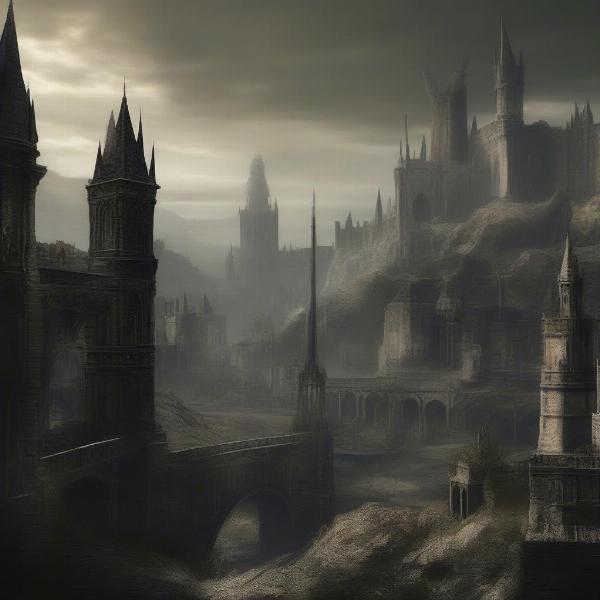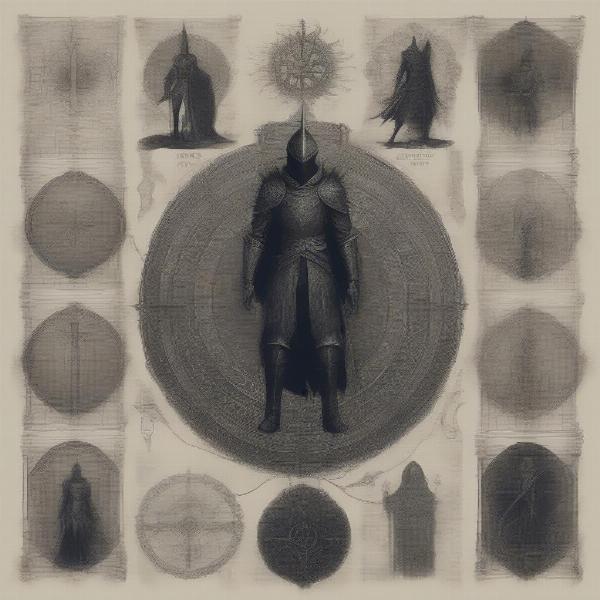The burning question on many a gamer’s mind: Are The Dark Souls Games Connected? The answer, like much of the lore in this notoriously challenging series, is complex and fascinating. While not directly connected in a continuous narrative like a typical trilogy, the Dark Souls games are intricately linked through shared themes, recurring characters, subtle references, and a deep, interwoven mythology.
Let’s delve into the interconnected world of Lordran, Drangleic, Lothric, and beyond, exploring the threads that tie these challenging yet rewarding experiences together. We’ll unravel the mysteries and connections between these iconic games.
Exploring the Connections Between Dark Souls Games
The connections between the Dark Souls games are not always explicit. You won’t find a straightforward storyline that directly carries over from one game to the next. Instead, the connections are often subtle, hinted at through item descriptions, environmental details, and cryptic dialogue. This approach allows players to piece together the puzzle themselves, fostering a sense of discovery and enriching the overall experience. This ambiguity is part of what makes the Dark Souls universe so captivating.
One of the most prominent connections is the recurring theme of cycles. The cycle of fire and dark, the rise and fall of civilizations, and the inevitable repetition of history are all central to the Dark Souls narrative. Each game explores these cycles in different ways, offering unique perspectives on the same underlying concepts. For instance, the Age of Fire waning is a constant theme, but how each game tackles the consequences differs. Similar gameplay mechanics, like bonfires and the challenging combat, further reinforce this sense of cyclical repetition and shared experience across the games.
Similar gameplay elements, especially the deliberate combat and emphasis on player skill, connect the titles. You could also argue that the consistent difficulty level creates a shared experience across the games, connecting players through a sense of shared accomplishment. If you’re curious if other popular titles share similarities, you might be interested in knowing if Bloodborne is a Dark Souls game. You can find more about that topic on our blog.
 Dark Souls Interconnected World: Depiction of Lordran, Drangleic and Lothric
Dark Souls Interconnected World: Depiction of Lordran, Drangleic and Lothric
The Recurring Characters and Items
Another key connection between the Dark Souls games is the presence of recurring characters and items. While not always the same individual, certain archetypes and items reappear, suggesting a shared history or lineage. For example, the Crestfallen Warrior, a recurring figure offering advice and guidance, appears in different forms throughout the series. Similarly, items like the Estus Flask and various types of souls demonstrate a connection across the different worlds. These recurring elements not only create a sense of familiarity but also hint at a larger, overarching narrative.
Even covenants, factions within the game world that players can join, have thematic and sometimes even literal connections across the games. For instance, the Way of Blue covenant serves a similar protective function in several games, further solidifying the interconnected nature of the world. Paying close attention to these details allows players to appreciate the depth and complexity of the Dark Souls universe.
The recurring presence of certain items, like specific rings or weapons, adds another layer to this interconnectedness. These items, often with unique lore and properties, transcend the individual game worlds, suggesting a deeper connection between them. For example, the recurring appearance of the Moonlight Greatsword throughout the series not only serves as a fan-favorite weapon but also as a symbolic link between the games. Furthermore, the prevalence of pyromancy across multiple games suggests a shared magical lineage and history.
 Recurring Characters and Items in Dark Souls: Illustration of recurring items and characters in the series
Recurring Characters and Items in Dark Souls: Illustration of recurring items and characters in the series
Lore and Mythology: Linking the Worlds
Perhaps the most significant connection between the Dark Souls games lies in their shared lore and mythology. Though each game tells a distinct story, they all draw from a common pool of myths, legends, and historical events. This creates a sense of a larger, interconnected world, even if the specific details remain fragmented and open to interpretation.
The Age of Fire and the cyclical nature of light and dark are central to the lore of the Dark Souls universe. Each game presents a different stage in this cycle, offering a unique perspective on its consequences. From the fading flame in Lordran to the reignition attempts in Lothric, these interwoven narratives paint a broader picture of a world grappling with inevitable cycles of decay and renewal. This deep, underlying mythology connects the games on a fundamental level, creating a rich and compelling universe.
Consider the concept of the First Flame, a foundational element in the Dark Souls mythos. This flame, and the cycles surrounding it, are referenced and reinterpreted in each game, creating a throughline connecting the individual narratives. The stories of Gwyn, the Lord of Cinder, and other key figures further contribute to this shared mythology, giving players glimpses into a rich and complex history that spans across all the games. You can see how this concept plays a role in games that share similarities with the series, such as exploring whether Elden Ring is a Dark Souls game.
 Lore and Mythology Connections in Dark Souls: Visual representation of the interconnected lore and mythology across the Dark Souls games
Lore and Mythology Connections in Dark Souls: Visual representation of the interconnected lore and mythology across the Dark Souls games
Are Dark Souls Games Connected to Other FromSoftware Titles?
While the Dark Souls games are interconnected, the question of their connection to other FromSoftware titles like Bloodborne and Sekiro is more complex. Though they share similar gameplay mechanics and design philosophies, these games exist in separate universes with distinct lore and mythology.
However, some fans speculate about subtle connections, pointing to recurring imagery and similar themes. These theories, while intriguing, remain largely speculative and are not explicitly confirmed by the developers. It’s more accurate to consider these games as spiritual successors, sharing a common DNA in terms of gameplay and atmosphere, rather than direct narrative sequels. To understand these connections better, you can check out our article on whether or not Bloodborne is part of the Dark Souls series. For those curious about the lengths of these souls-like games, you can also find an article detailing how long Lies of P’s full game is. And for fans of giant robots, we even have a discussion on whether mecha is a game genre.
Conclusion
So, are the Dark Souls games connected? Absolutely, but not in a conventional way. The connections are subtle, woven through the lore, recurring elements, and overall themes, inviting players to piece together the puzzle and uncover the rich tapestry of the Dark Souls universe. This interconnectedness adds a layer of depth and intrigue, rewarding those who delve deeper into the world and its mysteries. While each game stands on its own, exploring them together reveals a far grander and more interconnected narrative, making the experience even more rewarding.
FAQ
- Do I need to play the Dark Souls games in order? No, you can enjoy each game individually, but playing them in release order can enhance your understanding of the evolving lore and gameplay mechanics.
- Is Dark Souls a direct trilogy? Not in the traditional sense. While there are connections, each game tells a self-contained story within the broader Dark Souls universe.
- Are the stories in each Dark Souls game completely separate? While each game has its own narrative, they are linked by overarching themes, shared mythology, and recurring elements.
- How are the worlds in Dark Souls connected? The connections are primarily thematic and lore-based, hinted at through item descriptions, environmental details, and subtle references.
- What are some examples of recurring elements in Dark Souls? Recurring characters like the Crestfallen Warrior, items like the Estus Flask, and concepts like the Age of Fire are examples of connecting threads.
- Are there direct narrative sequels in Dark Souls? Each numbered entry is more of a spiritual successor than a direct sequel, exploring different aspects of the same interconnected world.
- What makes the Dark Souls connections so intriguing? The subtle and often ambiguous nature of the connections encourages player interpretation and discussion, enriching the overall experience.

